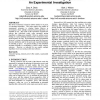Free Online Productivity Tools
i2Speak
i2Symbol
i2OCR
iTex2Img
iWeb2Print
iWeb2Shot
i2Type
iPdf2Split
iPdf2Merge
i2Bopomofo
i2Arabic
i2Style
i2Image
i2PDF
iLatex2Rtf
Sci2ools
SIGECOM
2000
ACM
2000
ACM
Interactions of automated pricing algorithms: an experimental investigation
The advent of electronic commerce enables retailers to set prices via automated algorithms. This paper employs the method of experimental economics to examine human behavior in environments where multiple automated pricing algorithms are available for use. The results of the experiments reported here indicate that individuals prefer using automated pricing algorithms to setting prices manually. However, neither a pricebeating nor a price-matching automated rule is dominant in terms of the frequency of usage. We find that the composite distribution of prices is a mean- and median-preserving spread for the gametheoretic distribution and for the previously reported distribution of manually set prices. Our primary finding is that individuals encounter difficulty in coordinating to achieve tacitly collusive outcomes. However, as indicated by one market, multiple algorithms do not necessarily preclude tacit collusion. Keywords Automated pricing, Internet posted offer markets, experimental e...
Related Content
| Added | 19 Dec 2010 |
| Updated | 19 Dec 2010 |
| Type | Journal |
| Year | 2000 |
| Where | SIGECOM |
| Authors | Cary A. Deck, Bart J. Wilson |
Comments (0)

